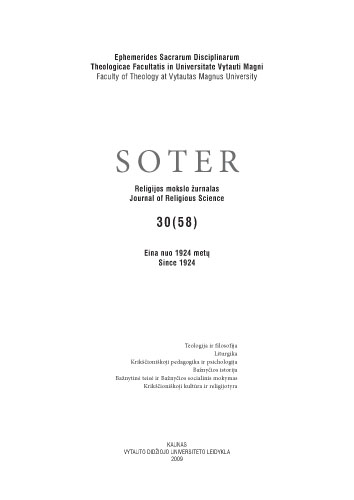Kryzys wśród braci mariańskich na Litwie 1933–1938
THE CRISIS OF MARIAN BROTHERS IN LITHUANIA 1933-1938
Author(s): Pawel ChudzikSubject(s): Christian Theology and Religion
Published by: Vytauto Didžiojo Universitetas
Keywords: marijonai; broliai; apaštalavimas; kongregacija; evangelizacija; krizė; Jurgis Matulaitis; Marians; brothers; apostolate; congregation; evangelization; crisis; Jurgis Matulaitis
Summary/Abstract: The role of the brothers in the monasteries had been changing over the years. Usually, only brothers belonged to the first monastery communities. Priests served them. As time went on, when the monasteries played a larger part in evangelical and missionary work, the monasteries changed their role. In new monasteries, for example, among the Jesuits and Piarists most members were priests. They took on the primary work of the monastery. There were not many brothers in those monasteries. Besides, they had fewer rights than priests; for example, they could not take on higher obligations. Brothers usually served priests by doing physical work. This happened similarly in the Marian congregation established in the second half of the 17th century - “to help the rectors in the work of the parish.” At first, there were not many brothers in the Marian congregation that pursued evangelical work. Later, they played a larger role in helping the priests and working on the monastery farm. Blessed Jurgis Matulaitis held a different point of view on brothers in the renewal of the Marian order. He had noticed a change in the demography of the followers of the Gospel and also knew that several groups within society held negative views on priests. Therefore, he wanted to include well-prepared brothers in the evangelical work. In order for this to happen, there had to be appropriate evangelical structures in the place. Matulaitis wanted brothers to visit workers in their homes. In his opinion, brothers could not only distribute charity to the workers and their families, but they could also encourage them to read good books, attend Mass, and provide other services. In this way, the Church wanted to suppress anti-church agitation, which was especially active among the workers. Blessed Jurgis Matulaitis wanted the brothers to participate in Catholic communities among the workers. Brothers were to provide a good example in both words and action. This important work of brothers was reflected within the entire structure of the monastery. According to the laws established by Matulaitis in this project, brothers had equal rights with priests. Unfortunately, the superiors of the Church did not approve of this idea. It seemed that the idea of Matulaitis would quickly be realized in Lithuania. Unfortunately, this did not happen. In the renewed monasteries, there were more candidates to priesthood than to brotherhood. But this situation quickly changed. In the late 1920s and early 1930s there were many candidates to brotherhood in the monasteries. At one point, about 50 brothers lived in the Marijampolė monastery. They were doing agricultural jobs in the monastery and in the Marian printing house. They also worked as carpenters, shoemakers, and tailors. They served not only the residents of the monastery, but also the town. Unfortunately, the work of the brothers was relegated to caretaking. In opposition to the ideas offered by Blessed Matulaitis, the brothers were not include
Journal: SOTER: religijos mokslo žurnalas
- Issue Year: 58/2009
- Issue No: 30
- Page Range: 115-126
- Page Count: 12
- Language: Polish

